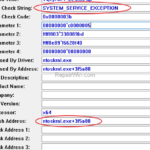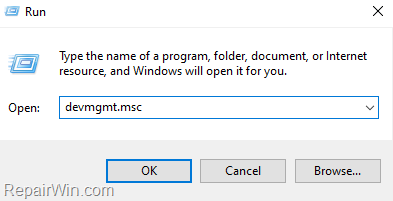The “SYSTEM_SERVICE_EXCEPTION” BSOD error in address “ntoskrnl.exe+3f5a80” in Windows, can occur for a variety of reasons and usually indicates a problem with a device, or a device driver), or the computer memory.
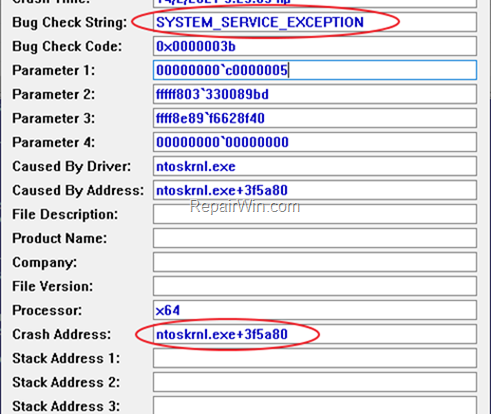
This guide contains step-by-steps instructions to solve the bsod error “SYSTEM_SERVICE_EXCEPTION caused by address ntoskrnl.exe+3f5a80”, in Windows 10, 8 or 7 OS.
Bug Check String : SYSTEM_SERVICE_EXCEPTION
Bug Check Code : 0x0000003b
Parameter 1 : 00000000`c0000005
Parameter 2 : fffff803`330089bd
Parameter 3 : ffff8e89`f6628f40
Parameter 4 : 00000000`00000000
Caused By Driver : ntoskrnl.exe
Caused By Address : ntoskrnl.exe+3f5a80
How to FIX: BSOD ntoskrnl.exe+3f5a80 in Windows 10.
Before troubleshooting bsod error “ntoskrnl.exe+3f5a80” follow these suggestions:
- If you recently added hardware to the system, try removing it and check if the problem persists.
- Check your system for viruses, malware or unwanted programs.
Method 1. Uninstall Updates.
Go ahead and uninstall the latest installed Windows Update to make sure that it does not cause this error.
A. If you can login to Windows:
1. Go to Start ![]() menu choose Settings
menu choose Settings ![]() and click Update & security.
and click Update & security.
2. Click View Update History and then click Uninstall Updates.
3. Sort the updates by the “Installed On” date and then locate and uninstall the latest update.
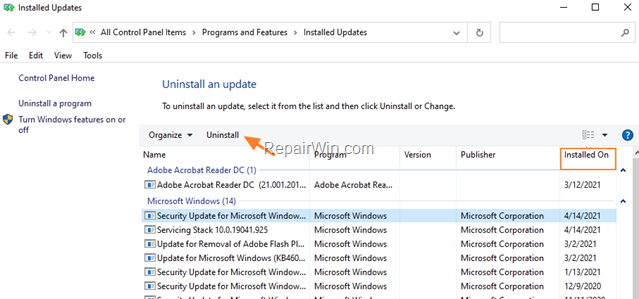
4. When the uninstall process is completed, restart your PC and see if the SYSTEM_SERVICE_EXCEPTION has resolved. If the problem is resolved and you believe that the Windows update is the culprit, navigate to Windows 10 Update History website and download and install the latest available update for your PC.
* Note for Windows 7 Users: To prevent the update to be installed again on your PC, navigate to Windows Update center and click Important Updates available link. Then right-click on the problematic update and click Hide update.
B. If you cannot log in to Windows:
1. Click See advanced repair options at the recovery screen. *
* Note for Windows 7 Users: Restart your computer and hit the F8 key while your computer is starting up and in ‘Advanced Options’ menu, choose Repair your Computer. Choose a Keyboard layout (e.g. “US”), select your account and then type your password (in case you have one).
At the ‘System Recovery options’ window, choose System Restore. Finally, proceed and select a previous restore point to restore your computer on it.
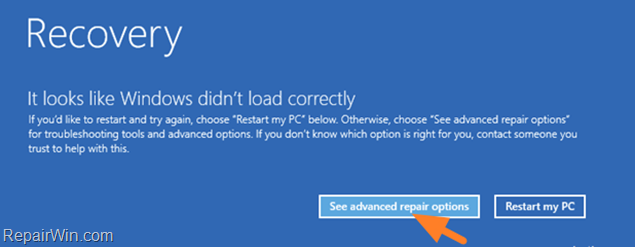
2. Then click Troubleshoot -> Advanced options -> Uninstall Updates -> Uninstall latest feature update.
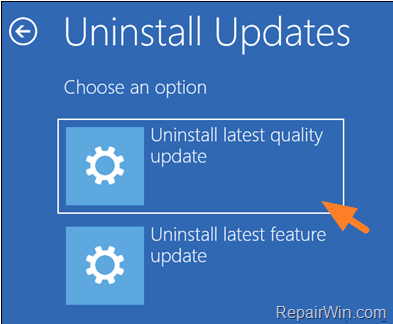
3. When the uninstall process is completed, restart your PC and see if the problem has resolved. If the problem is resolved and you believe that the Windows update is the culprit, navigate to Windows 10 Update History website and download and install the latest available update for your PC.
* Note for Windows 7 Users: To prevent the update to be installed again on your PC, navigate to Windows Update center and click Important Updates available link. Then right-click on the problematic update and click Hide update.
Method 2. Start Windows in Clean Boot State.
The second method of resolving the “ntoskrnl.exe+3f5a80” error is to start Windows in a clean boot mode, because the problem may be caused by a third-party program installed.
1. Press Windows ![]() + R keys to open the run command box.
+ R keys to open the run command box.
2. In the Search box, type: msconfig & click OK.
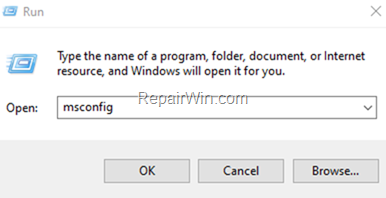
3. At Services tab:
a. Check the Hide all Microsoft Services checkbox.
b. Click Disable All and then click Apply.
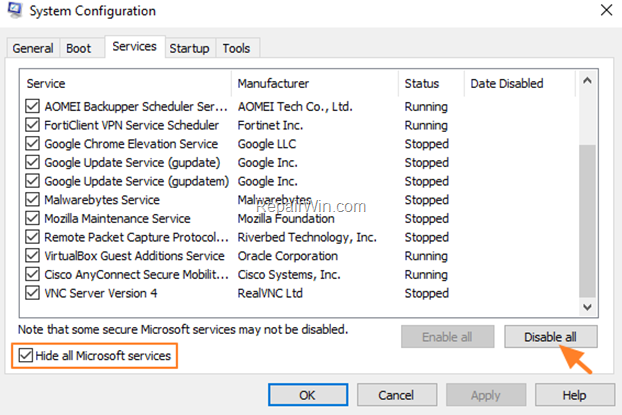
4. Now select the Startup tab and Open Task Manager. *
* Note: On Windows 7 OS, press Disable all, click OK & restart your PC.
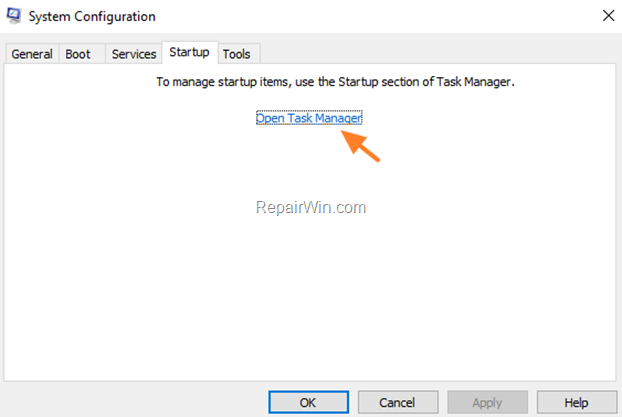
5. Disable all startup programs.
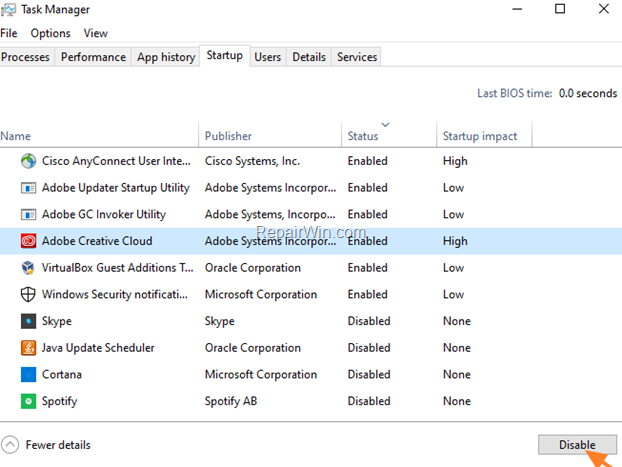
5. Restart the PC.
6. If after restart your computer is working fine and without problems. then open System Configuration utility (msconfig) again and enable one by one all disabled items and restart, until you find out which one causes problem.
Method 3. Update Device Drivers.
The SYSTEM_SERVICE_EXCEPTION error, may indicates a faulting device, or a faulting device driver. Therefore, first of all make sure that there are no devices that have an exclamation mark (!), Which indicates a problem.
At next, update all the device drivers on your system and especially uninstall and reinstall the device drivers for the Realtek Audio device and the Video device.
1. Open Device Manager. To do that:
1. Press Windows
+ R keys to open the run command box.
2. In the “Open” box, type: devmgmt.msc & click OK.
2. In device manager, expand the Sound, video and game controllers.
3. Right click on the Realtek Audio adapter and choose Uninstall device.
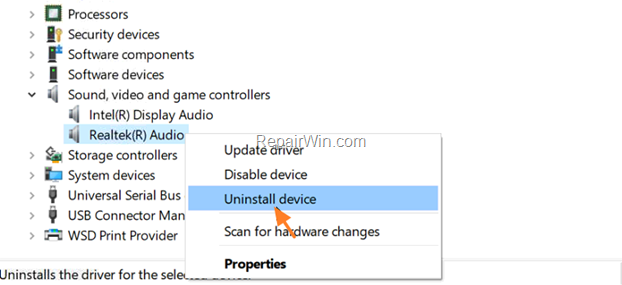
4. Check to Delete the driver software for this device and click Uninstall.
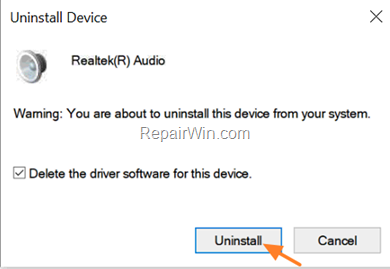
5. Restart you PC, and let Windows to install automatically the audio drivers.
6. Now check of the problems persists and if yes, proceed and update or re-install Video adapter’s drivers.
Method 4. Check Memory (RAM) and Hard Disk (HDD) for problems.
Blue Screen Problems, may be due to a damaged RAM module or a bad hard drive. To test and diagnose your RAM and HDD components for problems, follow the instructions in these guides:
- How to Diagnose Computer Memory problems with Memtest86+
- Best Hard Drive Test & Diagnostic Tools to Check Hard Disk’s Health
Method 5. Examine Minidump file.
When Windows crashes with a blue screen, stores the details of the BSoD screen to small file(s), which called “MiniDump“. The analysis of the Minidump file(s) can help you to troubleshoot and resolve the blue screen problem. To accomplish this task follow the instructions in this article: How to Analyze MiniDump Files with BlueScreenView.
That’s all! Did it work for you?
Please leave a comment in the comment section below or even better: like and share this blog post in the social networks to help spread the word about this solution.

